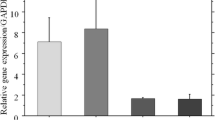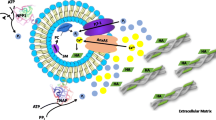Summary
Experiments were performed to determine whether β-glycerophosphate (β-GP) promoted mineralization in vitro by modulating bone cell metabolic activity and/or serving as a local source of inorganic phosphate ions (Pi). Using MC3T3-E1, ROS 17/2.8, and chick osteoblast-like cells in the presence of β-GP or Pi, we examined mineral formation, lactate generation, alkaline phosphatase (AP) activity, and protein and phospholipid synthesis. Neither β-GP nor Pi modulated any of the major biosynthetic activities of the bone cells. Thus, we found no change in the levels of phospholipids, and the total protein concentration remained constant. Measurement of lactate synthesis showed that β-GP did not effect the rate of anaerobic glycolysis. Evaluation of medium Pi levels clearly indicated that β-GP was hydrolyzed by bone cells; within 24 hours, almost 80% of 10 mM β-GP was hydrolyzed. It is likely that this local increase in medium Pi concentration promoted rapid mineral deposition. Chemical, energy dispersive X-ray, and Fourier transform infrared analysis of the mineral formed in the presence of β-GP showed that it was nonapatitic; moreover, mineral particles were also seen in the culture medium itself. Experiments performed with a cell-free system indicated that mineral particles formed spontaneously in the presence of AP and β-GP and were deposited into a collagen matrix. We conclude that medium supplementation with β-GP or Pi should not exceed 2 mM. If this value is exceeded, then there will be nonphysiological mineral deposition in the bone cell culture.
Similar content being viewed by others
References
Robison R (1923) The possible significance of hexosephosphoric esters in ossification. Biochem J 17:286–293
Robison R, Rosenheim AH (1934) Calcification of hypertrophic cartilage in vitro. Biochem J 28:684–698
Tenenbaum HC (1981) Role of organic phosphate in mineralization of bone in vitro. J Dent Res 60(C):1586–1589
Tenenbaum HC, Heersche JNM (1982) Differentiation of osteoblasts and formation of mineralized bone in vitro. Calcif Tissue Int 34:76–79
Ecarot-Charrier B, Glorieux FH, Van Der Rest M, Pereira G (1983) Osteoblasts isolated from mouse calvaria initiate matrix mineralization in culture. J Cell Biol 96:639–643
Whitson SW, Harrison W, Dunlap MK, Bowers DE, Fisher LW, Gehron Robey P, Termine JD (1984) Fetal bovine bone cells synthesize bone-specific matrix proteins. J Cell Biol 99:607–614
Gehron Robey P, Termine JD (1985) Human bone cells in vitro. Calcif Tissue Int 37:453–460
Bellows CG, Aubin JE, Heersche JNM, Antosz ME (1986) Mineralized bone nodules formed in vitro from enzymatically released rat calvaria cell population. Calcif Tissue Int 38:143–154
Gerstenfeld LC, Chipman SD, Glowacki J, Lian JB (1987) Expression of differentiated function by mineralizing cultures of chicken osteoblasts. Dev Biol 122:49–60
Bhargava U, Bar-Lev M, Bellows CG, Aubin JE (1988) Ultrastructural analysis of bone nodules formed in vitro by isolated fetal rat calvaria cells. Bone 9:155–163
Berry L, Shuttleworth CA (1989) Expression of the chondrogenic phenotype by mineralizing cultures of embryonic chick calvarial bone cells. Bone Miner 7:31–45
Masquelier D, Herbert B, Hauser N, Mermillod P, Schonne E, Remacle C (1990) Morphological characterization of osteoblast-like cell cultures isolated from newborn rat calvaria. Calcif Tissue Int 47:92–104
Bellows CG, Aubin JE, Heersche JNM (1991) Initiation and progression of mineralization of bone nodules formed in vitro: the role of alkaline phosphatase and organic phosphate. Bone Miner 14:27–40
Kodama H-A, Amagai Y, Sudo H, Ohno T, Iijima K-I (1986) Culture conditions affecting differentiation and calcification in the MC3T3-E1 osteogenic cell line. In: Ali SY (ed) Cellmediated calcification and matrix vesicles. Elsevier Science Publishers B.V., pp 297–302
Nishimoto SK, Stryker WF, Nimni ME (1987) Calcification of osteoblastlike rat osteosarcoma cells in agarose suspension cultures. Calcif Tissue Int 41:274–280
Thomas JT, Boot-Handford RP, Grant ME (1990) Modulation of type X collagen gene expression by calcium β-glycerophosphate and levamisole: implications for a possible role for type X collagen in endochondral bone formation. J Cell Sci 95:639–648
Luria EA, Owen ME, Friedenstein AJ, Morris JF, Kuznetsow SA (1987) Bone formation in organ cultures of bone marrow. Calcif Tissue Int 248:449–454
Tenenbaum HC (1987) Levamisole and inorganic pyrophosphate inhibit β-glycerophosphate-induced mineralization of bone formed in vitro. Bone Miner 3:13–26
Fortuna R, Anderson HC, Carty RP, Sajdera SW (1980) Enzymatic characterization of the matrix vesicle alkaline phosphatase isolated from bovine fetal epiphyseal cartilage. Calcif Tissue Int 30:217–225
Raisz LG, Dietrich JW, Canalis EM (1976) Factors influencing bone formation in organ cultures. Isr J Med Sci 12:108–114
Kakuta S, Golub EE, Shapiro IM (1985) Morphochemical analysis of phosphorus pools in calcifying cartilage. Calcif Tissue Int 37:293–299
Kakuta S, Golub EE, Haselgrove JC, Chance B, Frasca P, Shapiro IM (1986) Redox studies of the epiphyseal growth cartilage: pyridine nucleotide metabolism and the development of mineralization. J Bone Miner Res 1(5):433–440
Pacifici M, Oshima O, Fisher LW, Young MF, Shapiro IM, Leboy PS (1990) Changes in osteonectin distribution and levels are associated with mineralization of the chicken tibial growth cartilage. Calcif Tissue Int 47:51–61
Bradford MM (1976) A rapid and sensitive method for the quantitation of microgram quantities of protein utilizing the principle of protein-dye binding. Anal Biochem 72:248–254
Sasaki T, Hasegawa-Sasaki H (1985) Breakdown of phosphatidylinositol 4,5-biphosphate in a T-cell leukaemia line stimulated by phytohaemagglutinin is not dependent on Ca2+ mobilization. Biochem J 227:971–979
Golub EE, Schattschneider SC, Berthold P, Burke A, Shapiro IM (1983) Induction of chondrocyte vesiculation in vitro. J Biol Chem 258:616–621
Chen PS, Toribara TY, Warner H (1956) Microdetermination of phosphorus. Anal Chem 28:1756–1758
Jung K, Pergande M (1980) Influence of inorganic phosphate on the activity determination of isoenzymes of alkaline phosphatase in various buffer systems. Clin Chim Acta 102:215–219
Boskey AL, Posner AS (1977) The role of synthetic and bone-extracted Ca-phospholipid-PO4 complexes in hydroxyapatite formation. Calcif Tissue Res 23:251–258
Wuthier RE, Gore ST (1977) Partition of inorganic ions and phospholipids in isolated cell, membrane and matrix vesicle fractions: evidence for Ca-Pi-Acidic phospholipid complexes. Calcif Tissue Res 24:163–171
Boyan-Salyers BD, Boskey AL (1980) Relationship between proteolipids and calcium-phospholipid-phosphate complexes in bacterionema matruchotii calcification. Calcif Tissue Int 30:167–174
Rodan GA, Majeska RJ (1982) Phenotypic maturation of osteoblastic osteosarcoma cells in culture. Clin Biol Res 11(B):249–259
Rodan GA, Rodan SB (1983) Expression of the osteoblastic phenotype. In: Peck WA (ed) Bone and mineral research, Annual 2. Elsevier Science Publishers B.V., pp 244–285
Rodan GA, Heath JK, Yoon K, Noda M, Rodan SB (1988) Diversity of the osteoblastic phenotype. Ciba Foundation Symposium 136:78–91
Yoon K, Golub E, Rodan GA (1989) Alkaline phosphatase cDNA transfected cells promote calcium and phosphate deposition. Connect Tissue Res 22:17–25
Gronowicz G, Woodiel FN, McCarthy M-B, Raisz LG (1989) In vitro mineralization of fetal rat parietal bones in defined serumfree medium: effect of β-glycerol phosphate. J Bone Miner Res 3:313–324
Nordin BEC (1976) Calcium, phosphate and magnesium metabolism. Churchill Livingston, Edinburgh, London, New York
Scully RE (1980) Normal reference values. N Engl J Med 302:37–48
Hoffman WS (1970) The biochemistry of clinical medicine, 4th ed. Year Book Medical Publishers
Geigy Scientific Tables, Lentner C (ed) (1984), vol 3, 8th ed. Ciba-Geigy
Author information
Authors and Affiliations
Rights and permissions
About this article
Cite this article
Chung, CH., Golub, E.E., Forbes, E. et al. Mechanism of action of β-glycerophosphate on bone cell mineralization. Calcif Tissue Int 51, 305–311 (1992). https://doi.org/10.1007/BF00334492
Received:
Revised:
Issue Date:
DOI: https://doi.org/10.1007/BF00334492




